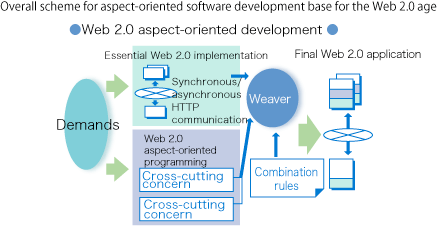AOSD4Web2.0 Project: Aspect-Oriented Software Development for Web 2.0
Separation of Concerns and Automatic Synthesis Everywhere
Project Outline
The age of Web 2.0 is at hand, emphasizing the dispersion and interoperability of Web applications, convenience, diversity of execution and operating environment and development efficiency. The essence of technologies in the Web 2.0 is late binding, in which services are dynamically discovered and synthesized.
However, many conventional late binding techniques delayed the combination of completed modules, more than the determination of the contents of modules themselves. The aspect-oriented technology separates the static structures and dynamic behavior that are dispersed among numerous module groups into separate modules (called aspects), and results in late binding by delaying the timing of their synthesis. In Web application development today, the application of aspect-oriented technologies has progressed as a container framework. On the other hand, in application development toward Web 2.0, the application of aspect-oriented technologies has not been fully developed, especially at the client side.
This project will therefore create a development methodology consisting of aspect-oriented programming techniques and analysis/design techniques, with the aim of establishing a development base for Web 2.0-oriented application. Specifically, a practical environment for aspect-oriented programming is realized first, for Web 2.0 application development that employs JavaScript at the client side. In the medium to long terms, aspect-oriented techniques are applied to P2P network communication technologies with an even higher degree of dispersion and interoperability (messaging for example) and Web service technologies, in relation to JavaScript. Moreover, aspect-oriented modeling and development techniques are established that recognize, separate and synthesize the aspect starting from the analysis/design stage.
The aspect-oriented software development environment, which is an outcome of the project, is expected to facilitate the separation of concerns, while encouraging ease of maintenance, usability, performance, development efficiency and the separation of the development system and work for applications that employ asynchronous communication and dynamic modifications.

Major partner organizations and members
Waseda University : Hironori Washizaki, Yoshiaki Fukazawa, Atsuto Kubo, Tomohiko Mizumachi
National Institute of Informatics : Nobukazu Yoshioka
NTT Data Corporation : Takashi Okamoto


